Categories: Featured Articles » Electrician at home
Number of views: 9346
Comments on the article: 2
220V network voltage stabilizers - comparison of various types, advantages and disadvantages
Each house has a mass of household appliances, costing from units to tens and even hundreds of thousands of rubles. In order for her to serve as long as possible, she needs to be monitored, taken care of and carry out all maintenance work, if any. However, only power surges remain a danger.
In household electrical networks, they occur frequently, they can be caused by switching of powerful electrical equipment, as well as problems on the lines, such as poor contact, dilapidated supports, and so on. To reduce the risk of equipment failure due to poor power supply, you can use voltage stabilizers 220V. In this article we will consider what they are and how they differ.

Auto transformer
Before starting a review of the types of electric stabilizers, we will consider what an autotransformer is, because it underlies most modern stabilizers.
Autotransformer - differs from the usual prefix “auto” in the name, it stands for “itself”. The fundamental difference from a conventional transformer is that it has one winding, it is also primary and secondary. In the figure below you see its diagram.

If the autotransformer is conventionally divided into primary and secondary sides, then the voltage is supplied not to the ends of the windings, but between one end and the tap. Then between the extreme ends of the windings the voltage will be higher than the input.
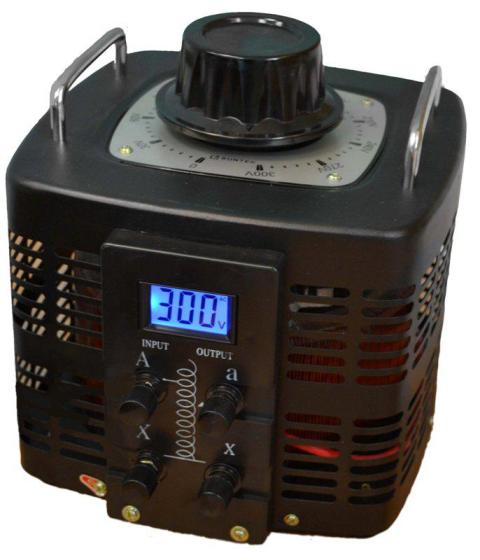
Autotransformers can be performed either with several taps from the winding, for the implementation of a step-by-step switching of the output voltage. But most laboratory autotransformers provide a smooth adjustment of the "output", how is this organized?

To do this, the output terminals are connected to a sliding contact - a graphite brush, which relieves tension from its turns. This node is shown in the photo below.
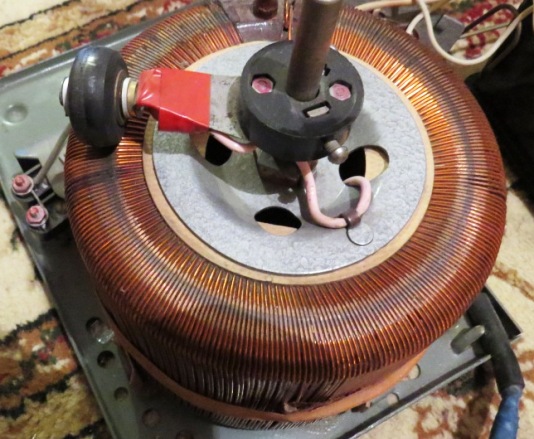
Types and characteristics
First, consider the classification by type and their characteristics. Stabilizers are distinguished by the method of stabilization and voltage regulation:
1. Ferroresonant.
2. Relay.
3. Electromechanical or servo-driven;
4. Electronic or inverter, with semiconductor switches.
When choosing a stabilizer of any type, you first need to look at its characteristics. Perhaps the main one is power, it is indicated in VA - volt-amperes or kVA - kilovolt-amperes.
Note:
Volt-amperes are a unit of measurement of apparent power, which consists of the sum of active and reactive powers. You pay for active power, which is measured in watts (W) or kilowatts (kW), and power consumption is kW / h, respectively.
In addition to power, you also need to pay attention to the error in regulating the output voltage and the input range, as well as the reaction rate to voltage changes.
This should be taken into account when choosing a device, because if you calculate the amount of active power consumed by the devices and buy a stabilizer “end-to-end”, it may not withstand it. To determine the total power, the active should be multiplied by the cosine phi - this Power factoris equal to the ratio of active power to full, then the total power is equal to the quotient of active and coefficient:
Gross Power = Active Power / cosF
Efficiency and inrush currents must also be considered. In any case, take a stabilizer with a total power reserve of 30-40%, ideally 50% of the planned capacity of consumers.
For instance:
If the total power of the protected devices is 3 kW, then it is better to purchase a stabilizer for 4-4.5 kVA.
Distinguish between single-phase and three-phase voltage stabilizers, but since single-phase input is more common in household power networks, then we will focus on such stabilizers.
Ferroresonant stabilizer
A ferroresonant stabilizer will protect electrical equipment from power surges. It consists of two chokes and a capacitor, its approximate circuit is shown in the figure below.
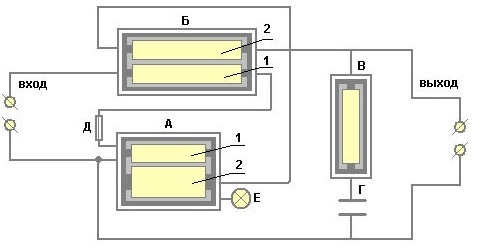
They are cheap, but do not provide real stabilization of the output voltage, although they do provide some protection for electrical equipment. Currently, the market is not too common. For normal and safe operation of your equipment, they should not be considered. The figure below shows its appearance.

It should be remembered that its advantages are durability, since there are no actuators and speed.
Relay stabilizer
The relay stabilizer is based on an autotransformer and a control system based on relay and microcontroller. The principle of operation is to switch the taps from the autotransformer turns to achieve a stable voltage of the output network. An approximate diagram of such a stabilizer is shown below:

The diagram shows that the relay stabilizer provides step-by-step adjustment of the output voltage. Hence there is an error in the regulation of the output voltage of about 8%. In fact, the error depends on the number of steps.
As it was said, the taps from the transformer winding are switched using electromechanical relays, and to ensure both increase and decrease work, the autotransformer is made in such a way that 4 taps for lowering the output voltage and 3 taps for increasing are permissible.
Relays operate quickly enough, the reaction speed of the stabilizer. Depending on the type of specific relays, they operate in 2-7 milliseconds. The device itself provides switching stages and the final reaction in 2-12 milliseconds.

The transformer itself and the switching relays are visible in the photo - these are the blocks in the black cases behind it.
The more relays are installed, the greater the accuracy of adjustment and the range of operating voltages. Some models operate in the voltage range of 100-290V.
Their advantages:
-
cheapness;
-
reliability;
-
do not interfere with the network;
-
most models have additional functions, such as surge protection, voltage supply from input to output directly. This mode is called bypass (bypass), it is necessary to reduce losses on the transformer at a normal value of the supply voltage. Protection against short circuit and overheating can also be integrated;
-
service life of 8-15 years;
-
excellent maintainability - if the relays fail, they can be easily, quickly and cheaply replaced. critical is the failure of the transformer or control board;
-
high efficiency - 97-99%.
The disadvantage is the stepwise adjustment. Some may not be happy with regular clicks when switching relays. However, they are not too loud.
Relay stabilizers are well suited for powering refrigerators, washing machines and other appliances with motors and heaters.
Electromechanical or servo-driven voltage stabilizers
Servo-driven voltage stabilizers resemble a laboratory autotransformer in principle, the only difference is that the voltage is automatically regulated, by servo.
With this design, it is impossible to provide a sharp reaction to voltage changes, the reaction rate is in the range of 10-15 volts per 1 second. Therefore, it is well suited for areas where low or high stress is constantly observed, or even floats during the day. This often happens in villages and the private sector. They will respond to smooth changes in the supply voltage and provide a stable output at 220 V.
Benefits:
-
smooth voltage adjustment;
-
precision adjustment.
Disadvantages:
-
wear of moving parts, and the need for their regular prevention or replacement;
-
the operation of the stabilizer is quite noisy due to sounds from the servo drive and the movement of the current collector along the winding, which means that when the input voltage changes, you will hear a buzz;
-
dust and humidity are the evil enemies of any electrical appliance, but in the case of a servo-driven stabilizer, this is especially critical, since in fact the main functional unit inside is in the open state.
Electronic voltage regulator
In fact, this is the same relay stabilizer, but instead of the relay, semiconductor switches are used - thyristors or triacs. This provides quiet switching and faster response.

Thyristor models have a similar device:
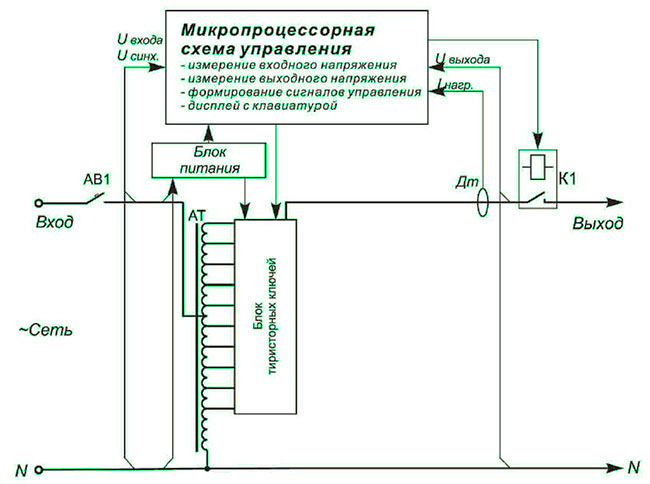
If the voltage in the network is within normal limits, the electronic stabilizer control system will turn on the bypass mode and put current in bypass of the transformer. This is necessary to increase efficiency.

This video compares the operation of the relay and electronic voltage stabilizer:
Benefits:
1. Reliability. Semiconductor keys are not characterized by mechanical wear of the contacts.
2. Performance is an order of magnitude higher.
3. Noiselessness.
Disadvantages:
1. The cost is higher than that of relay models.
2. The ability to short-term overload of semiconductor switches is lower than that of electromechanical relays.
3. Symmistors can also fail if a high-voltage pulse breakdown occurs, but manufacturers minimize these problems.
Inverter Stabilizer
Another name for this type of instrument is double conversion stabilizers. The block diagram of the device is shown in the figure below.

That is, in this circuit, the voltage goes to the input filter of electromagnetic interference, then to the corrector of the power factor (it may not be in cheap models) then it is rectified and goes to the inverter and to the output circuit to the load. Thus, the output voltage does not affect the output and the reaction rate of the stabilizer with a double converter is higher than that of other types.
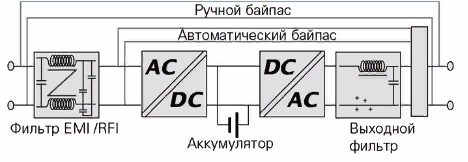
The only limitation is the input voltage range, which is limited by the characteristics of the inverter circuit. The inverter with the transformer is involved in the double conversion, therefore, the galvanic isolation of the input and output circuits is also provided. This is more clearly reflected in the diagram below, although this is an uninterruptible power supply circuit, but the meaning is the same.
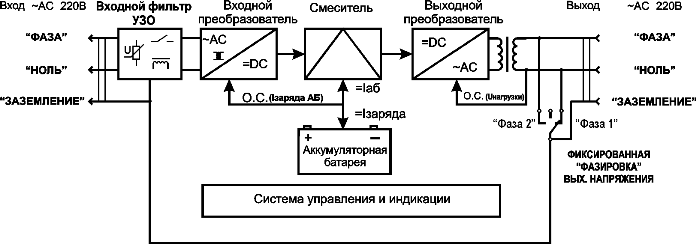
Below is an example of an electrical principle similar device.

Accordingly, the conditional voltage graph at the input and output of the stabilizer with double conversion.
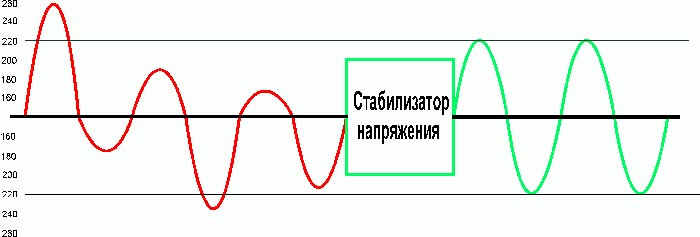
Benefits:
-
Noiselessness;
-
Accuracy and speed adjustment;
-
Large input voltage range.
The disadvantage is the cost.
Conclusion
All stabilizers are good in their own way, and installing any of them will improve the working conditions of electrical appliances and extend their service life. However, you should take into account the speed and draw conclusions if surge pulses often occur in your mains.
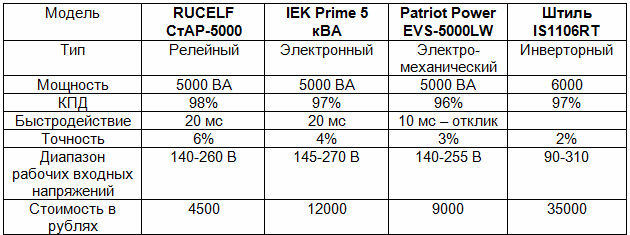
In order to summarize and make the right choice, read the table, I picked up several models of different types of approximately the same power. Prices are taken from Yandex.Market and are indicated for July 2018.
See also at bgv.electricianexp.com
:
